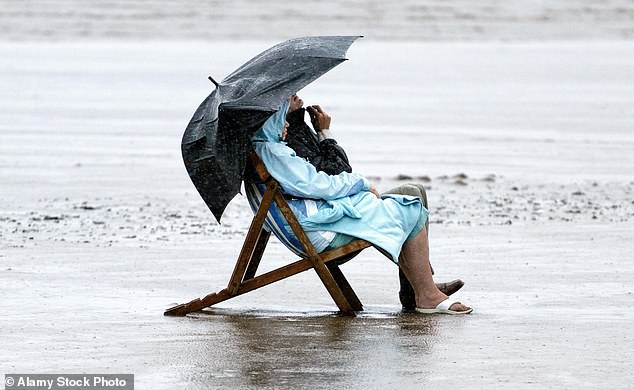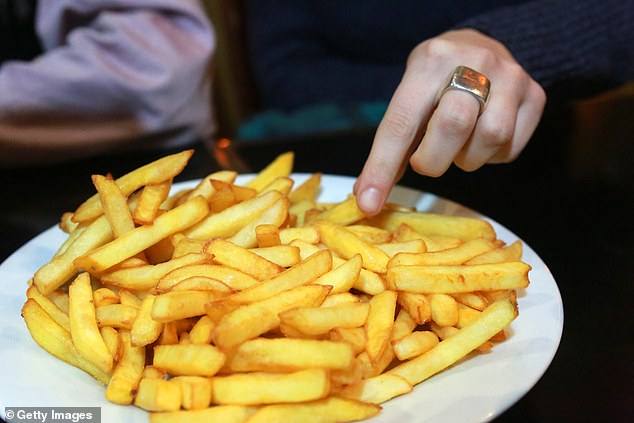It’s dampened our spirits, ruined many a get-together and washed out countless sporting events, but could the cloudy, damp summer we’ve endured so far also now be harming our health — by depriving us of the vital sunshine nutrient vitamin D?
After last week’s mini heatwave, it’s back to mixed mild sun and rain for the foreseeable future, making this an important question — for vitamin D is essential to maintain the health not only of our bones, but also to keep our immune system working effectively, among other things. It’s even being investigated as a way to reduce the risk of dementia.
However, without access to sunshine — or the outdoors, it seems — most people won’t make enough to meet their needs.
Our main source of vitamin D is exposure to the ultraviolet B (UVB) radiation in sunlight; this triggers cholesterol in our skin to start a series of chemical reactions that create vitamin D.
But the amount of cloud we’ve had so far this summer (the average hours of sunshine have been well down on normal) will raise fears that we are not getting enough sunshine. The weather has also been so wet — parts of the UK experienced the wettest May on record, according to the Met Office — that people have been spending more time than usual indoors.

The weather has been so wet – parts of the UK experienced the wettest May on record, according to the Met Office
Even when the weather is more favourable many of us are vitamin D‑deficient. The latest UK National Diet and Nutrition Survey reports that between 2008 and 2012, nearly a quarter of adults aged 19 to 64 and one in five adults over 65 had inadequate levels in their blood.
In the dark and cloudy winter months of January to March, this figure increased to four in ten people aged 19 to 64, and three in ten over-65s.
Older people are more at risk of a deficiency as they become less able to absorb the vitamin from food (we get small amounts from oily fish and eggs, for instance) and their bodies become less efficient at producing it.
However, there is some good news — while our sunlight exposure is likely to be ‘a bit down’ this year, there are multiple factors that affect how much vitamin D you make so that this may not be an issue, says Adrian Martineau, a professor of respiratory infection and immunity at Queen Mary University of London.
‘The ability of sunshine to synthesise vitamin D in the skin relates to the intensity of UVB rays, and that intensity is affected by cloud cover and latitude. So the further you are from the equator, the more atmosphere the sun’s rays have to travel through before the rays hit Earth,’ he explains.
That’s why in the summer, when our part of the world is tilted towards the sun, the intensity of its rays hitting the UK increases, so we should be able to top up our vitamin D levels.
Yet there are other factors at play, he says. ‘These include the time of day — UVB is strongest between 10am and 2pm — how much time you spend outside and if you wear a sunblock.’ (Although some experts say that people rarely apply sunscreen thickly enough to block vitamin D production.)

Vitamin D is essential to maintain the health not only of our bones, but also to keep our immune system working effectively
And behaviour really is significant, for while you might assume hotter countries have less of an issue with vitamin D shortfalls, that’s not the case. ‘Saudi Arabia has far higher rates of vitamin D deficiency than we do in the UK, because it can be so hot that they don’t go outside in the sun,’ says Professor Martineau.
The fact vitamin D is so crucial to our wellbeing is why in 2016 the Department of Health recommended that, between October and March, all adults and children should consider taking a daily 10 mcg supplement, as in winter we often don’t get strong enough sunshine to trigger adequate vitamin D production.
Spring exposure to sunlight is arguably most important as ‘it is in the spring when our levels tend to be the lowest and when we need the biggest boost’, says Professor Martineau.
While a short burst of sunlight can help top up your levels — as vitamin D is a fat-soluble vitamin it can be stored in the body and used at a later date — it has a limited shelf life.
‘The half-life of calcidiol [the form of vitamin D that circulates in the body] is one to two months, which means if you were in a submarine or suddenly deprived of sunlight, your vitamin D stores would halve every one to two months,’ adds Professor Martineau.
Yet the summer weather doesn’t have to be great to replenish your vitamin D levels. Susan Lanham-New, a professor of human nutrition at the University of Surrey, who was part of the governmental working group that produced the 2016 recommendations, says there can be enough UVB even on a cloudy day to help boost levels — so long as you can get outside.
‘It does not matter necessarily if it is a sunny day, you can still get sufficient UVB exposure,’ she told Good Health. ‘So long as it’s from April to September, the UVB wavelength is strong enough. Even if it’s cloudy in these months, you should get sufficient UVB exposure to enable your body to produce sufficient vitamin D.’
Crucially, however, she adds: ‘Our findings suggest that as a daily minimum, you should spend ten to 20 minutes in the sunshine — but not in any way allowing your skin to burn.’
People with darker brown skin that hardly ever burns may need to spend 25 minutes in sunlight to get adequate exposure because their skin absorbs UVB less readily, according to a University of Manchester study reported in the journal Nutrients in 2018.
As for taking a vitamin D supplement, Professor Lanham-New says: ‘Unless you can’t get outside — because, for example, you are frail or elderly — or are not allowed to expose your skin for cultural reasons, you won’t need to take a supplement between April and September.’ She adds: ‘It won’t do any harm if you do take a moderate-dose supplement year-round, although you could be wasting your money.’
Indeed, research also shows that vitamin D pills don’t provide a full substitute for consuming the vitamin in a healthy diet.
In 2022, a five-year Harvard Medical School study, which followed 26,000 midlife men and women who took daily supplements, reported in The New England Journal of Medicine that even in people with low levels of the vitamin, the pills don’t prevent fractures or osteoporosis.
The study found the supplements don’t bring the benefits that even getting small amounts of the vitamin naturally from foods such as oily fish, eggs and red meat may provide.
Other sources include fortified breakfast cereals, breads and some children’s yoghurts.
NHS dietitian Catherine Collins adds: ‘Mushrooms can be a good source, too, which is useful for vegans. It’s produced in the gills in the undersides in response to sunlight, so you have to turn them upside down and leave them on a windowsill for a few days.’
If anyone needs more encouragement to get out into the sunshine, there are health benefits beyond vitamin D.
A study in 2014 by Dr Richard Weller, honorary consultant dermatologist at the University of Edinburgh, found that sunlight boosts our levels of nitric oxide.
‘This chemical dilates blood vessels and lowers our blood pressure,’ he says. ‘My work shows that natural sunlight seems to prevent hypertension and cardiovascular disease, the biggest killer in the world.’
It all makes getting outdoors this summer — even if it’s cloudy and damp — so much more enticing.
Additional reporting: Lucy Elkins
Recycling starts at home
How your body ‘reuses’ things. This week: Oestrogen
Some women’s menopause occurs later than the average age of 51. One theory is that they are more efficient at recycling oestrogen.
When ‘old’ oestrogen reaches the gut after touring the body, it’s either expelled in poop or gut bacteria, known as the estrobolome, produce an enzyme that ‘reactivates’ it.
‘There is some evidence of the impact of female hormones on the gut microbiome, as well as that hormones are reabsorbed from the gut,’ says Dr Shazia Malik, a consultant obstetrician and gynaecologist at the Royal Free London NHS Foundation Trust and the Portland Hospital.









